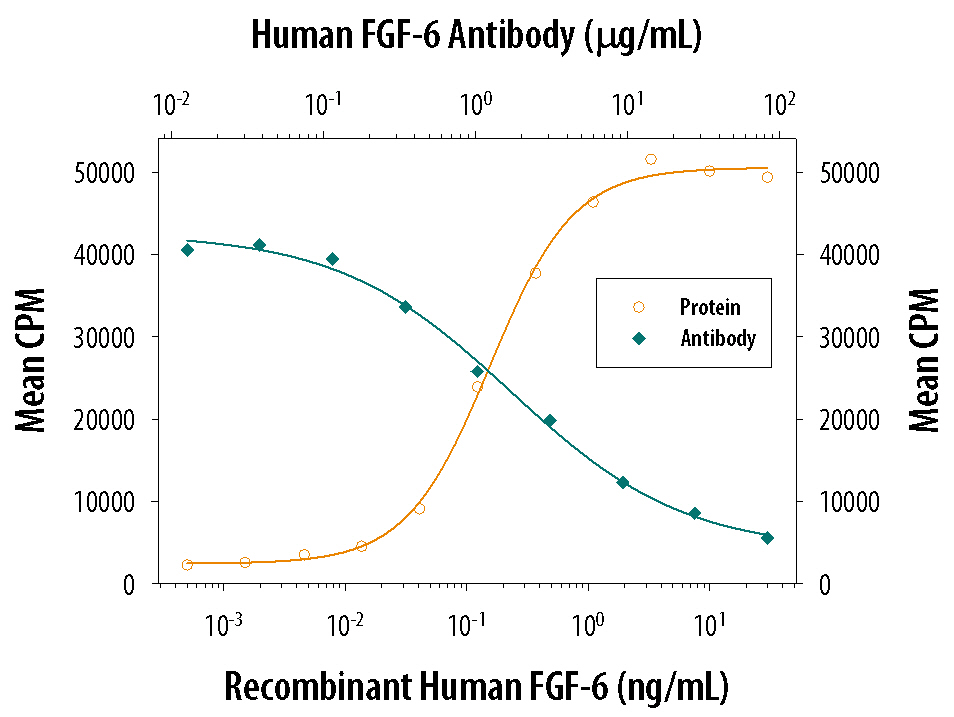Human FGF-6 Antibody
R&D Systems, part of Bio-Techne | Catalog # MAB238

Key Product Details
Species Reactivity
Validated:
Human
Cited:
Human
Applications
Validated:
ELISA Capture (Matched Antibody Pair), Neutralization
Cited:
ELISA Development
Label
Unconjugated
Antibody Source
Monoclonal Mouse IgG1 Clone # 27028
Product Specifications
Immunogen
E. coli-derived recombinant human FGF-6
Ala53-Ile208
Accession # P10767
Ala53-Ile208
Accession # P10767
Specificity
Detects human FGF-6 in ELISAs. In direct ELISAs, approximately 75% cross-reactivity with recombinant human (rh) FGF-5 and less than 10% cross-reactivity with rhFGF-4 is observed. Does not neutralize the activity of FGF acidic, FGF basic, rhFGF-4, or rhFGF-5.
Clonality
Monoclonal
Host
Mouse
Isotype
IgG1
Endotoxin Level
<0.10 EU per 1 μg of the antibody by the LAL method.
Scientific Data Images for Human FGF-6 Antibody
Cell Proliferation Induced by FGF-6 and Neutralization by Human FGF-6 Antibody.
Recombinant Human FGF-6 (Catalog # 238-F6) stimulates proliferation in the the NR6R-3T3 mouse fibroblast cell line in a dose-dependent manner (orange line). Proliferation elicited by Recombinant Human FGF-6 (1 ng/mL) is neutralized (green line) by increasing concentrations of Mouse Anti-Human FGF-6 Monoclonal Antibody (Catalog # MAB238). The ND50 is typically 1-4 µg/mL in the presence of heparin (1 µg/mL).Applications for Human FGF-6 Antibody
Application
Recommended Usage
Neutralization
Measured by its ability to neutralize FGF-6-induced proliferation in the NR6R-3T3 mouse fibroblast cell line. Rizzino, A. et al. (1988) Cancer Res. 48:4266. The Neutralization Dose (ND50) is typically 1-4 µg/mL in the presence of 1 ng/mL Recombinant Human FGF-6 and 1 µg/mL heparin.
Human FGF-6 Sandwich Immunoassay
Please Note: Optimal dilutions of this antibody should be experimentally determined.
Formulation, Preparation, and Storage
Purification
Protein A or G purified from ascites
Reconstitution
Reconstitute at 0.5 mg/mL in sterile PBS. For liquid material, refer to CoA for concentration.
Formulation
Lyophilized from a 0.2 μm filtered solution in PBS with Trehalose. *Small pack size (SP) is supplied either lyophilized or as a 0.2 µm filtered solution in PBS.
Shipping
Lyophilized product is shipped at ambient temperature. Liquid small pack size (-SP) is shipped with polar packs. Upon receipt, store immediately at the temperature recommended below.
Stability & Storage
Use a manual defrost freezer and avoid repeated freeze-thaw cycles.
- 12 months from date of receipt, -20 to -70 °C as supplied.
- 1 month, 2 to 8 °C under sterile conditions after reconstitution.
- 6 months, -20 to -70 °C under sterile conditions after reconstitution.
Background: FGF-6
References
- Wiedlocha, A. and V. Sorensen (2004) Curr. Top. Microbiol. Immunol. 286:45.
- Mohammadi, M. et al. (2005) Cytokine Growth Factor Rev. 16:107.
- Marics, I. et al. (1989) Oncogene 4:335.
- Ornitz, D.M. et al. (1996) J. Biol. Chem. 271:15292.
- Pizette, S. et al. (1991) Cell Growth Differ. 2:561.
- Asada, M. et al. (1999) Growth Factors 16:293.
- Ropiquet, F. et al. (2000) Cancer Res. 60:4245.
- de Lapeyriere, O. et al. (1993) Development 118:601.
- Li, J. et al. (1993) Cancer 72:2253.
- Floss, T. et al. (1997) Genes Dev. 11:2040.
- Grass, S. et al. (1996) Development 122:141.
Long Name
Fibroblast Growth Factor 6
Alternate Names
FGF6, HBGF-6, HST2
Gene Symbol
FGF6
UniProt
Additional FGF-6 Products
Product Documents for Human FGF-6 Antibody
Product Specific Notices for Human FGF-6 Antibody
For research use only
